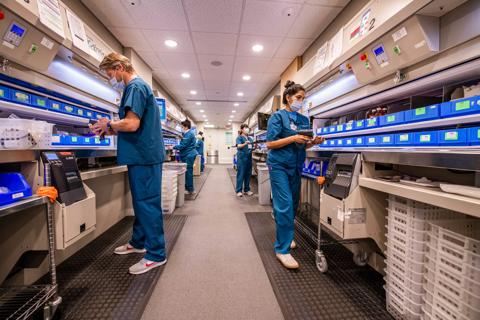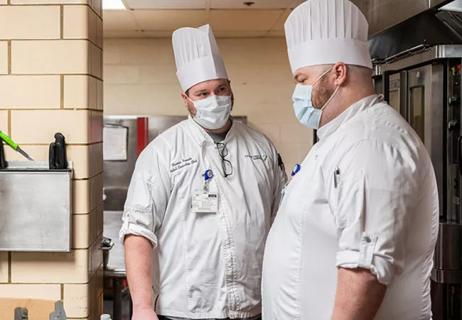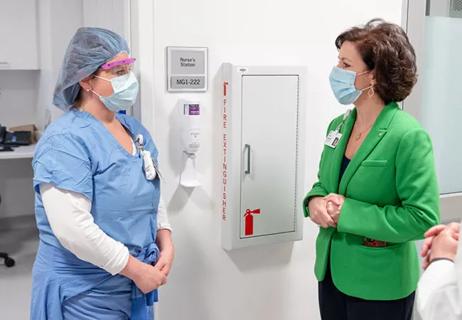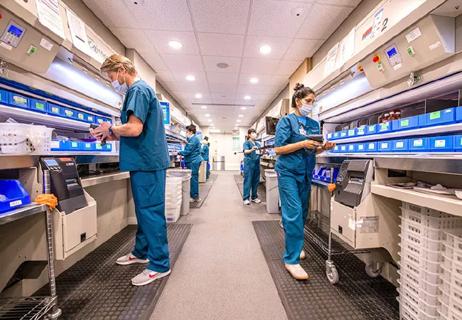Develop career pathways and other resources

By K. Kelly Hancock, DNP, RN, NE-BC, FAAN, Chief Caregiver Officer
Cleveland Clinic is a non-profit academic medical center. Advertising on our site helps support our mission. We do not endorse non-Cleveland Clinic products or services. Policy
A few months ago, I was inspired by a conversation I had with a caregiver from Cleveland Clinic’s environmental services team. The employee approached me in a hospital hallway as I was exiting the elevator. She told me that while she does a good job and takes great pride in her work, she knew she could offer our organization more.
This employee wanted something different for her career, but she didn’t know where to turn to make it happen. By the end of the conversation, I connected her with the right people in our Caregiver Office so she could share more about her goals and discuss career alternatives within our health system.
It’s not uncommon for people to want to change their career path. These days, it’s typical for people to make between three and seven career changes throughout their lifetime. My experience with the caregiver proved to be a good reminder that it’s vital for healthcare organizations to offer employees internal career pathway options — and to make sure people are aware of them.
A successful career pathway will lead employees from entry level roles into more complex careers. Ideal pathways include those for roles such as environmental services workers, health unit coordinators, medical assistants, patient care nursing assistants, patient transporters and phlebotomy technicians.
Organizations should ensure that pathways support employees through meaningful development. A career-path guide can show employees a customized view of progression options and the necessary skills, education and experience needed to develop toward the opportunity. Identify resources that point employees in the right direction to enhance their education, skills and experience for the desired position.
In addition to a guide, career profiles that contain job descriptions can offer a clear understanding of what a day in the life of an employee in a given position might be like. Keep profiles simple and easy to read.
It’s important that managers are educated on available career paths, that they are aware of employees’ aspirations, and that they advocate for them and encourage upward progression. No one wants to lose a good worker to another position, but an employee’s career satisfaction are most important. Their skills may be better suited for another role, allowing them to make a greater contribution to the organization and its patients. Investing in employees in this way and encouraging the use of other competencies and capabilities will increase retention and engagement, reduce turnover, and have a positive effect on things such as care quality, patient experience and operational efficiencies.
Managers can keep a pulse on employee career goals through individual employee development plans, employee touch-base meetings and more. Cleveland Clinic’s Mandel Global Leadership & Learning Institute offers our leaders tools and guidance on available career paths, how to identify talent for those paths, and how to conduct individual development planning with focused conversations that support employee development.
We also offer embedded program managers through our Caregiver Office to help with career readiness, sourcing and preparing employees for future job opportunities. They serve as coaches and guide employees in growing skills within pathways. They share success stories of other employees who started in entry-level positions and advanced greatly, which can be highly inspiring. And they are partners in accountability.
Organizations can make the most out of internal career pathway offerings by also creating other complementary resource-based programs that aid employees in exploring career options and advancement opportunities. Some of the programs Cleveland Clinic has created are listed below.
Learn and earn programs, like apprenticeships, are another way organizations can introduce employees to alternate career opportunities. These combine meaningful on-the-job experience with aligned classroom learning. Cleveland Clinic offers apprenticeships in pharmacy, IT, finance and imaging.
Communication and education is key to any employee development program. The environmental services employee I met knew that she wanted to make a change, but needed guidance on how to initiate the process. To help close the awareness gap, use intentional communications from HR, managers, and department and institution leaders. Be sure to use multiple methods – online, in-person and email – to spread the word.

Flexibility, support and foundational skills are key

Friendship highlights the advantages of mentorship, coaching and collaboration

Strong professional, personal and strategic networks foster creativity, help build robust careers

Meaningful connections support growth and development

Chief Caregiver Officer mines her experience for helpful insights

Cleveland Clinic programs lead to credentials and careers

Organizations must be intentional about helping individuals grow

Recruiters use candidate-centric approach to meet job seekers’ needs